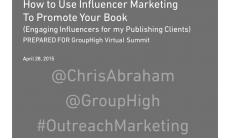There’s been a lot written about content creation, placement, and promotion in recent months. In fact, you know Content Marketing is gaining in importance when universities start creating CM course curricula and incorporating them into their digital marketing programs. I’m going to attempt to connect some dots touching on all three of those CM disciplines beginning with this short blog post intro.
To begin with, there has been an apparent shift to more short form and visually based content (image over text) to suit the small screen user. The “push,” or offer based content sent to the majority of smartphone and tablet users is based on predicted interest and anticipated future behavior. An attempt to time the market is at play. I’m zeroing in on the increasing body of research knowledge and hopefully providing a touch of wisdom in the mix.
My exploration of this sub topic started with a Pew Research study on the use and retention of various content forms suited to different platforms vs. their simple share-ability. By now, most of us have been faced with marketing challenges posed by the decreasing attention span of mobile users. The trend towards changing length and depth of most content has given rise to listicles, infographics, curated summaries, and the like. It seems that as we are connecting with more data, we are communicating less.
In contrast, Pew pointed out the obvious: that we devote more time with content we genuinely care about. This became all too real to me in past B to C efforts where the undeniable truth was that the majority of mass audiences weren’t buying what I was selling. That Coupon Content as some have called it is, by its nature aimed at bottom funnel folks who probably know little about my product, brand or genuinely care about either. Short form content like this does indeed draw more traffic initially because it is more prolific and digestible, for reasons already mentioned. But long form content draws more engagement, especially on large screens, because of its more focused setting and breath of a visual canvas. On top of that, we tend to spend more time with content referred by others, especially those we know who share common interests expressed in that content. We spend the least time on newsfeeds or broadcasted pitches on social platforms, because we don’t care about something directed at a generic mass audience, unless we’re looking for whatever it is.
According to Buzz Sumo, long format content is shared more and fully digested (read in its entirety) more because the connection is based on relevancy, not timing or predicted behavior. Individualized, person-to-person content deployment over a carefully outlined buying journey and ownership cycle can incorporate couponing, but more importantly builds customers and advocates instead of just generating cheap clicks. This is where the art of content creation offers a lot of opportunity and room to grow.
Really good content marketing happens when content moves you before, during, or after a transaction. That is, if a transaction is even your conversion goal. It becomes memorable when its message becomes part of your personal experience as much as the product. This notion is now giving rise to Interactive Content involvement because it is contextual and reciprocal. While the increasing monetization of Social Media platforms as ad revenue streams results in fewer opportunities for personalized conversions from brands, and ever higher cost, we are forced to search for new content venues to gain lost organic reach.
So, for those still practicing Coupon Content marketing exclusively, I’d like to propose a different path. That of a Content Annuity. Are many in the B to C world to continue with a relentless barrage of offers till something happens out of sheer attrition; or will they practice Content Marketing as a strategy on Branding for lead nurturing, customer conversion, and advocacy? Owned content like the latter stimulates social sharing with relevancy and context. It works harder in SEO and frequently gets picked up by media and mentioned by influencers. This blog post has done that for me in its own simplistic way.
Even as the big social platforms are seeing this as fertile ground for ad revenue in future marketing, those of us entrusted with a brand identity could be well served looking to what type of content we can create and its ultimate use as the place for growth. So while Facebook is working on ad revenue in its own more personalized content messaging and Snapchat is already gaining momentum, the notion of quality over quantity and repetition cannot be lost. More on this in my next post.







